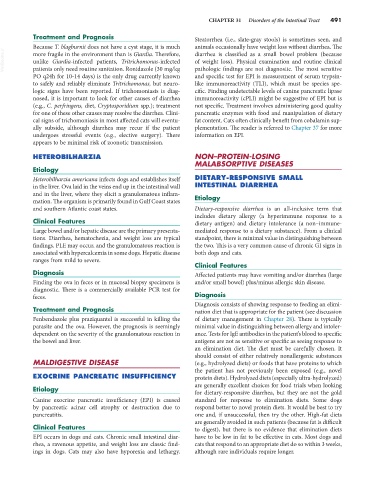Page 519 - Small Animal Internal Medicine, 6th Edition
P. 519
CHAPTER 31 Disorders of the Intestinal Tract 491
Treatment and Prognosis Steatorrhea (i.e., slate-gray stools) is sometimes seen, and
Because T. blagburnii does not have a cyst stage, it is much animals occasionally have weight loss without diarrhea. The
VetBooks.ir more fragile in the environment than is Giardia. Therefore, diarrhea is classified as a small bowel problem (because
of weight loss). Physical examination and routine clinical
unlike Giardia-infected patients, Tritrichomonas-infected
patients only need routine sanitation. Ronidazole (30 mg/kg
and specific test for EPI is measurement of serum trypsin-
PO q24h for 10-14 days) is the only drug currently known pathologic findings are not diagnostic. The most sensitive
to safely and reliably eliminate Tritrichomonas, but neuro- like immunoreactivity (TLI), which must be species spe-
logic signs have been reported. If trichomoniasis is diag- cific. Finding undetectable levels of canine pancreatic lipase
nosed, it is important to look for other causes of diarrhea immunoreactivity (cPLI) might be suggestive of EPI but is
(e.g., C. perfringens, diet, Cryptosporidium spp.); treatment not specific. Treatment involves administering good quality
for one of these other causes may resolve the diarrhea. Clini- pancreatic enzymes with food and manipulation of dietary
cal signs of trichomoniasis in most affected cats will eventu- fat content. Cats often clinically benefit from cobalamin sup-
ally subside, although diarrhea may recur if the patient plementation. The reader is referred to Chapter 37 for more
undergoes stressful events (e.g., elective surgery). There information on EPI.
appears to be minimal risk of zoonotic transmission.
HETEROBILHARZIA NON–PROTEIN-LOSING
MALABSORPTIVE DISEASES
Etiology
Heterobilharzia americana infects dogs and establishes itself DIETARY-RESPONSIVE SMALL
in the liver. Ova laid in the veins end up in the intestinal wall INTESTINAL DIARRHEA
and in the liver, where they elicit a granulomatous inflam- Etiology
mation. The organism is primarily found in Gulf Coast states
and southern Atlantic coast states. Dietary-responsive diarrhea is an all-inclusive term that
includes dietary allergy (a hyperimmune response to a
Clinical Features dietary antigen) and dietary intolerance (a non–immune-
Large bowel and/or hepatic disease are the primary presenta- mediated response to a dietary substance). From a clinical
tions. Diarrhea, hematochezia, and weight loss are typical standpoint, there is minimal value in distinguishing between
findings. PLE may occur, and the granulomatous reaction is the two. This is a very common cause of chronic GI signs in
associated with hypercalcemia in some dogs. Hepatic disease both dogs and cats.
ranges from mild to severe.
Clinical Features
Diagnosis Affected patients may have vomiting and/or diarrhea (large
Finding the ova in feces or in mucosal biopsy specimens is and/or small bowel) plus/minus allergic skin disease.
diagnostic. There is a commercially available PCR test for
feces. Diagnosis
Diagnosis consists of showing response to feeding an elimi-
Treatment and Prognosis nation diet that is appropriate for the patient (see discussion
Fenbendazole plus praziquantel is successful in killing the of dietary management in Chapter 28). There is typically
parasite and the ova. However, the prognosis is seemingly minimal value in distinguishing between allergy and intoler-
dependent on the severity of the granulomatous reaction in ance. Tests for IgE antibodies in the patient’s blood to specific
the bowel and liver. antigens are not as sensitive or specific as seeing response to
an elimination diet. The diet must be carefully chosen. It
should consist of either relatively nonallergenic substances
MALDIGESTIVE DISEASE (e.g., hydrolyzed diets) or foods that have proteins to which
the patient has not previously been exposed (e.g., novel
EXOCRINE PANCREATIC INSUFFICIENCY protein diets). Hydrolyzed diets (especially ultra-hydrolyzed)
are generally excellent choices for food trials when looking
Etiology
for dietary-responsive diarrhea, but they are not the gold
Canine exocrine pancreatic insufficiency (EPI) is caused standard for response to elimination diets. Some dogs
by pancreatic acinar cell atrophy or destruction due to respond better to novel protein diets. It would be best to try
pancreatitis. one and, if unsuccessful, then try the other. High-fat diets
are generally avoided in such patients (because fat is difficult
Clinical Features to digest), but there is no evidence that elimination diets
EPI occurs in dogs and cats. Chronic small intestinal diar- have to be low in fat to be effective in cats. Most dogs and
rhea, a ravenous appetite, and weight loss are classic find- cats that respond to an appropriate diet do so within 3 weeks,
ings in dogs. Cats may also have hyporexia and lethargy. although rare individuals require longer.

